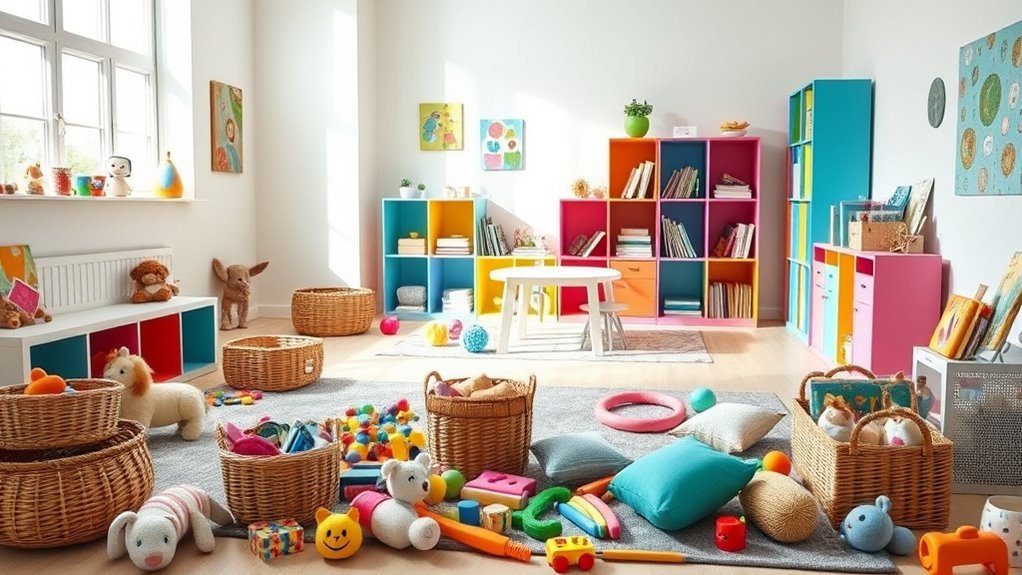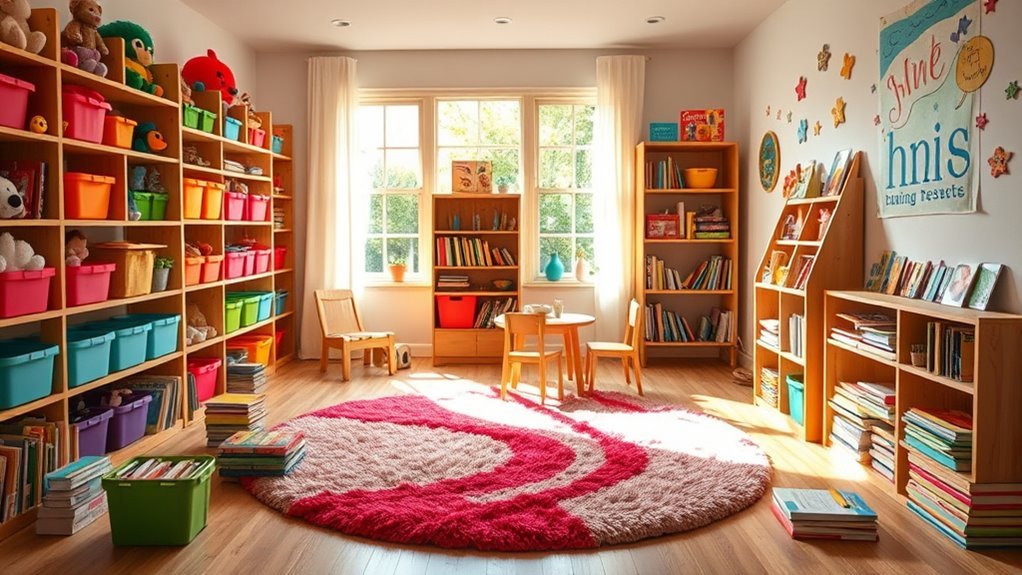Cleaning and Organizing a Kids’ Playroom
To clean and organize your kids’ playroom, start by evaluating the space and sorting toys into keep, donate, or store piles. Choose storage solutions like open shelves or bins that suit your space and lifestyle. Create zones for different activities and establish simple daily cleanup routines to keep clutter at bay. Involving your kids in organizing teaches responsibility and makes tidying up fun. Keep going to discover more tips for a functional, joyful playroom.
Assessing the Current Playroom Setup

Where should you begin when tackling a messy playroom? Start by evaluating space and identifying needs. Take a good look around and consider how the room is currently used. Is the layout working, or does it feel cramped? Are there areas that are underutilized or cluttered beyond repair? Think about the kids’ habits and preferences—what toys or activities do they use most? Pinpointing these needs helps you make informed decisions about storage and organization. Don’t rush; this step is about understanding your starting point so you can create a system that truly supports freedom and playfulness. By honestly appraising the space and figuring out what’s essential, you set the stage for a functional, enjoyable playroom that both you and the kids will appreciate.
Sorting and Decluttering Toys
Sorting and decluttering toys is an essential step to reclaim order in your playroom. Start by separating toys into categories: keep, donate, or store for seasonal rotation. This frees up space and simplifies playtime, letting your kids enjoy their favorites without clutter. Consider involving them to decide what to keep or donate, teaching valuable lessons about sharing through toy donation.
| Action | Benefit |
|---|---|
| Keep | Immediate access to favorites |
| Donate | Give joy to others, reduce clutter |
| Seasonal Rotation | Keeps playroom fresh and engaging |
Choosing the Right Storage Solutions

Once you’ve decided which toys to keep, the next step is finding storage solutions that fit your space and lifestyle. You want options that make tidying easy without tying you down. Consider versatile shelf options that can grow with your kids and adapt to changing needs. Open shelves keep toys visible and accessible, encouraging independence and quick cleanups. Toy bins are perfect for grouping similar items and slipping under beds or into closets, freeing up floor space. Choose bins with labels or clear sides to save time hunting for favorites. Remember, storage solutions should simplify your life, not complicate it. By picking smart shelf options and toy bins, you create a playroom that feels open and manageable—giving everyone the freedom to enjoy and maintain the space.
Establishing Daily Cleanup Routines
Although it might seem like a hassle at first, establishing a daily cleanup routine can make maintaining your kids’ playroom much easier. By setting simple cleaning schedules, you create a predictable rhythm that encourages your kids to take responsibility without feeling overwhelmed. Keep it short and consistent—like a five-minute tidy-up before dinner—so it doesn’t feel like a chore stealing freedom from playtime. To motivate them, consider implementing reward systems that celebrate their efforts, whether it’s extra storytime or choosing a weekend activity. This way, cleanup becomes a positive habit instead of a dreaded task. With daily routines in place, you’ll enjoy a clutter-free space that frees everyone from chaos and helps your kids develop lifelong organization skills naturally and joyfully.
Creating Zones for Different Activities

When you divide the playroom into clear zones for different activities, it becomes easier for your kids to know where everything belongs and what they can do in each space. Setting up distinct activity zones lets your children enjoy focused play without distractions. You can create a reading nook, a building block corner, and creative spaces for drawing or crafting. This structure encourages independence, as kids freely move between zones based on their interests. Plus, it keeps the room orderly since toys and supplies have designated spots. By thoughtfully arranging these zones, you provide an environment that balances fun and organization, giving your kids the freedom to explore while making cleanup straightforward. Clear activity zones make the playroom a space everyone can enjoy with ease.
Involving Kids in the Organization Process
Getting your kids involved in organizing their playroom not only teaches responsibility but also makes them more likely to keep the space tidy. You can turn this into a fun activity that boosts team collaboration and empowers them to make choices. Let them sort toys by type or color, and create storage labels together. Here’s a simple plan:
| Task | Kid’s Role | Your Role |
|---|---|---|
| Sorting toys | Group by type/color | Guide and encourage |
| Labeling bins | Help create labels | Provide materials |
| Decluttering | Choose items to keep | Support decisions |
| Setting up zones | Arrange items | Guarantee safety |
Frequently Asked Questions
How Often Should I Deep Clean the Playroom?
You should deep clean your playroom about once a month to keep things fresh and clutter-free. Sticking to a playroom maintenance schedule helps you stay on top of messes and toy chaos without feeling overwhelmed. Use a deep cleaning checklist to tackle dust, sanitize surfaces, and organize toys efficiently. This way, you’ll enjoy a tidy space that gives your kids freedom to play and you freedom from stress.
What Are the Best Non-Toxic Cleaning Products for Kids’ Toys?
Wondering what’s truly safe for your little one’s toys? You’ll want to choose cleaning products with eco friendly ingredients that protect both your child and the planet. Homemade cleaners, like a simple mix of vinegar, water, and a few drops of essential oil, offer a powerful, non-toxic alternative to harsh chemicals. By making your own, you gain freedom from worries about harmful residues while keeping toys sparkling clean and safe for play.
How Can I Childproof the Playroom Effectively?
To childproof your playroom effectively, start by rethinking the playroom layout to minimize hazards and keep frequently used toys within easy reach. Incorporate safety measures like covering electrical outlets, securing furniture to walls, and using corner guards on sharp edges. Make sure storage bins are sturdy and accessible so your child can explore freely but safely. This way, you’ll create a space where they can enjoy playtime with maximum freedom and minimal risk.
What Are Creative Ways to Label Toy Bins?
Imagine each toy bin as a treasure chest waiting to be opened. You can use colorful labels with fun fonts to spark excitement and make sorting feel like a game. Try symbols or pictures that represent the toy inside—like stars for superheroes or animals for plushies—giving kids freedom to explore and organize independently. This way, labeling becomes a playful adventure, not just a chore, inspiring creativity and joyful order.
How Do I Handle Sentimental Toys During Decluttering?
When handling toys with sentimental value, you’ll want to strike a balance between keeping memories and freeing up space. Consider setting aside a special box for those truly meaningful items. For others that still hold some attachment but aren’t essential, think about toy donation—it’s a great way to pass on joy while lightening your load. This approach helps you honor memories without feeling weighed down by clutter.






